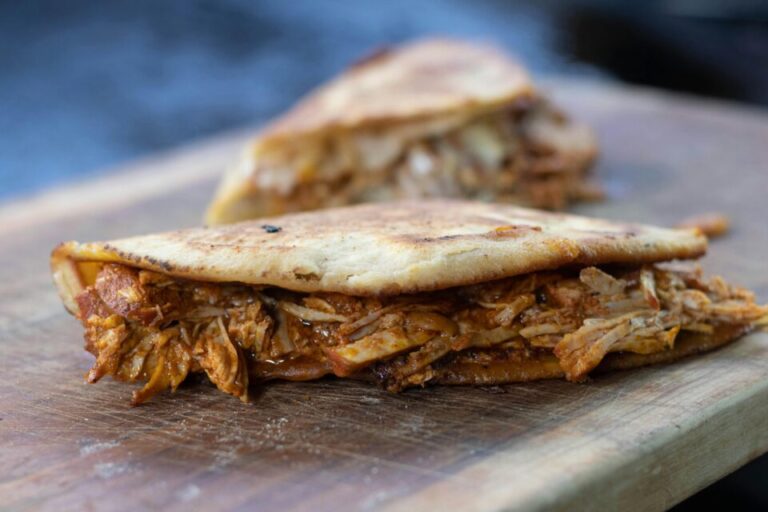Arepas are a must-have in Venezuela and Colombia. They’re these flat, round patties made with cornmeal that you can grill, bake, or fry. You can even eat them split or as a sandwich. The word arepa actually comes from “erepa”, which means corn in the dialect of the Caracas Indians. Fun fact:
corn was super vital to them since they believed humans were created from it. There are lots of stories out there about how arepas came to be but one that is well-known is about this young woman in Caracas who made corn and water into patties to survive. Her neighbors caught on and soon enough, the idea spread all over Venezuela and even to other Latin American countries.
As we progress in the article, we will discuss Venezuelan Arepas in context and give you details on how to make Arepas, types of Arepas, origin of Venezuelan Arepas and much more.
What are Venezuelan Arepas?
An Arepa is a dish which is consumed in numerous Spanish-speaking nations. It could be a flat, round, unleavened patty made of cornmeal, which can be grilled, baked, fried, boiled or steamed. The characteristics and name of the Arepa vary based on the country of origin; in this case, we’re looking at the Venezuelan Arepa.
Venezuelan Arepas are thought to have originated from the indigenous tribes of Venezuela. They were known to grind maize, shape it into dough and cook it. Rolling onto the modern ages, the Spaniards influenced the recipe a little with the addition of grains and it was at this point that the term “Arepas” was recognized.
Due to its inexpensive nature and flexibility, Arepas gained fame as a daily diet for Venezuelans. In today’s context, notwithstanding social status, everybody in Venezuela eats Arepas since they’re great and cheap.
History Of Arepas
Before we proceed, let us talk about arepas for a bit. Back in the day, corn was utilized as a type of money . The story goes that arepas originated during the Spanish Conquest when African slaves taught the people of Cumanagoto (presently Cumana, in Sucre state) how to grind corn. At that time, the arepa was known as a cornbread made by the local people.
Native Americans, moreover, had their own way of making them by barbecuing, frying in hot ashes or cooking in clay pots. These delightful treats were a staple in the Spaniards’ diet as they were more nutritious than the Elizabethan staple for sea voyages called “hardtack”.
Presently, the word “arepa” has a bit of a fuzzy origin, Some say it comes from the Caracas locale and the word “erepa”, which means corn in the Taino dialect spoken in Northern South America. Others think it’s from the Cumanagoto dialect, where “arrapan” implies corn. And there are those who accept it comes from the Caquetio dialect spoken in the Orinoco region, where “aripa” implies corn.
But no matter where it came from, one thing’s for sure: arepas have a profound history in Venezuela and are considered a national symbol in numerous regions.
How To Make Arepas
In the making of any type of great arepa, nothing is more vital than the texture of the final product. A successful arepa ought to have a crispy external layer and a soft interior texture. Unfortunately, this ideal texture is often difficult to achieve using the tortilla guideline of food preparation and arepas are regularly served with a tough or hard texture. This is because the arepa is often fried or grilled and neither of these strategies allows the insides of the arepa to achieve the delicate, spongy texture that is desired.
Arepas are formed from precooked corn flour and fillings for arepas are restricted only by the imagination and are sometimes made from the leftovers of previous meals. In any case, a few types of filling are conventional, widely accepted and well worth special preparation. Examples of fillings that can be used in the preparation of Arepas are cheese, ham, eggs, veggies, etc.
Types Of Arepas
Arepas have a significant position in Colombian and Venezuelan culture. They are served for almost any meal and often used as sandwich bread. Whether you prefer with a simple filling for breakfast or splitting them open and loading them with various fillings for lunch or dinner, arepas are versatile and delicious. Here are some types of Arepas you might know:
1. Traditional Arepas
Arepas is a traditional food in Venezuela and Colombia and is very well known and consumed more often than bread. These delectable Arepas are made from ground maize dough or cooked flour and can be prepared by grilling, baking or frying.
The characteristics and names of arepas change depending on the particular region. Remarkably versatile, arepas can be savored on their own or delighted in with different accompaniments. They are especially delightful when split open and filled, resembling a sandwich.
The filling alternatives are abundant and range from a basic slice of cheese to the traditional perico, consisting of scrambled eggs with onion and tomato, to the more extravagant reina pepiada, composed of a heavenly avocado-based chicken salad. Furthermore, arepas can be served as a complimentary side dish, much like a dinner roll and are typically enjoyed hot with a pat of butter.
2. Sweet Arepas
It’s difficult to be indifferent to the delight of these delicious, sweet arepas. These arepas are so versatile that they can be served as breakfast, a side dish or a snack by simply adjusting the filling or the ingredients.
However, it is a lesser known fact, especially outside of Venezuela, that arepas can be sweet. Sweet arepa is achieved by simply adding sugar, and possibly a little vanilla essence, to the basic arepa dough recipe.
It seems pretty easy, and it completely is, but the results are, like, mind-blowing. The yummy taste of these arepas makes them super great for breakfast, particularly since you can top them with any syrup, jam, or marmalade you want. They’re also a bomb snack any time of day and go great with sweetened coffee.
If you want to make them into a dessert, you can totally try stuffing them with a mix of butter and sugar or even custard. And in case you need to get a little fancy with these arepas, you may try adding a few grated veggies or fruits to the dough. They’re particularly great with carrots, pumpkins or apples.
3. Modern Arepas
Arepas have evolved over time, and since then, new recipes have been formed and arepas are not just plain masa cake. Some modern arepas are made with cheese in the dough, and a few are even cut open and filled with cheese after they are cooked. There are also sweet arepas made with, you guessed it, sugar.
These are usually only eaten in certain areas of Colombia and Venezuela. They aren’t fried, but done up in the oven and eaten as a dessert. Another interesting type of arepa is the arepa de choclo, which is an arepa made with sweet corn.
The batter is actually made from corn kernels instead of masa. Moreover, there are a variety of gourmet arepas emerging in restaurants nowadays that are made with unexpected ingredients such as avocado, chicken or fish.
4. Regional Arepas
There are different types of Colombian arepas that differ depending on the region and its indigenous cultures. The three main types of arepas in Colombian regions are:
Arepa “santandereana” from the Santander region, Arepa “valluna” or “de choclo” from the Andean region, and Arepa “costeña” from the Atlantic coast. Each has distinctive presentations, ingredients, and preparation methods.
Arepas aren’t just part of the Colombian way of life; they are also an essential food for Colombians. They imply national roots and traditions and are stuck to the Colombian way of life. In Colombia, arepas are a typical breakfast food that can be consumed any time of the day.
Evolution of Arepas Over Time
Arepas have changed over time to fit in with all the happenings in Venezuela. They were something that the indigenous people made back in the day. They’d take some corn cake and cook it on a stick over a fire or in a heap of hot coals. These are pretty much the same as the arepas made presently, but the indigenous people utilized a special kind of corn called “flint corn” to make them.
Then the Spanish showed up in 1498 and presented modern stuff to the area. They taught the indigenous people how to grow different things from Africa and the “new world.” They showed them how to grow plantains, sugar cane, and a very important crop called European cereal. This cereal flour ended up replacing the original corn arepas since it took less time to make and was way better for the way society was changing.
This discovery of wheat flour made a huge difference in how arepas were made. The recipe had only been flour, salt, and water, but the Spaniards utilized animal fat to cook with. That led to adding butter, eggs, and milk to the recipe. That’s why arepas presently have a super crispy exterior and a rich and creamy interior.
In Venezuela, arepas are a staple of the common folk, sold as street food by vendors who may specialize in this one product or may sell a variety of foods. Most of the time, arepas are the simplest, cheapest fast food and can even serve as a complete meal. Try Venezuelan Arepas today and thank me later!




